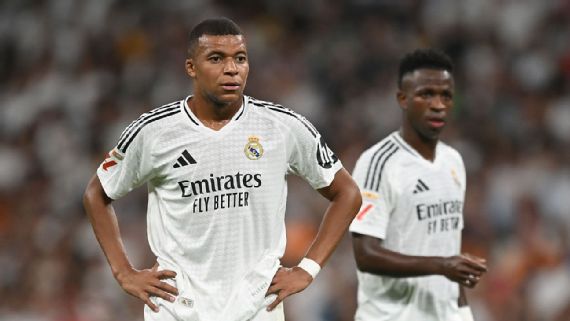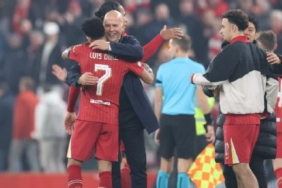We just started … and now it’s break time. After four matchdays in Spain, three in England, Italy and France and only two in Germany, the first international break of the 2024-25 season is already here. The season began in absurdly disjointed fashion, and such a quick break feels particularly unnecessary after a summer that saw major tournaments such as Euro 2024. (The U.S. hasn’t even officially hired its new coach yet after firing the last one after Copa America.) Still, the break is probably welcome for a few teams that suffered false starts in August.
It’s too early for any team to truly panic — except maybe Everton, who should feel free to do so — but some of Europe’s most celebrated clubs head into this (absurd and unnecessary) break with problems to address and goals that feel less likely than they did at the start of the season. From Real Madrid dropping points (unacceptable at all times), to AC Milan and Spurs getting sliced apart in transition, to Manchester United and Roma forgetting how to shoot, to Valencia creating nothing of value, to Bayer Leverkusen losing (!!!), let’s talk about seven major clubs and just how close they should be to pressing the panic button.
• 2023-24: first in LaLiga (2.50 points per game, +1.6 goal differential per game)
• 2024-25 to date: second (2.00 points per game, +1.3 goal differential per game)
This one’s all about where you set the bar. Real Madrid are second in LaLiga. They haven’t lost a league match since last September, and haven’t lost a match of any sort since January. They’ve already won a trophy this season (hey, the UEFA Super Cup does count), but we set the bar ridiculously high for this club, and they simply aren’t clearing it at the moment. They haven’t played a good first half all season, and while winning with beautiful bursts of brilliance is the “Real Madrid Way,” they’re a little too reliant on that at the moment: In all three of their season wins, they scored twice in 10 minutes and otherwise plodded along.
In both of their LaLiga road matches to date, those winning bursts never arrived. They suffered 1-1 draws against both Mallorca (who genuinely outplayed them) and Las Palmas, and that has already put them four points behind a torrid Barcelona. And if you compare their underlying numbers to the quality of their league opponents to date, they’re clearly underachieving a bit.
For the seven teams in this piece, here’s a look at both their xG differential and the average Opta power rating of their opponents to date.
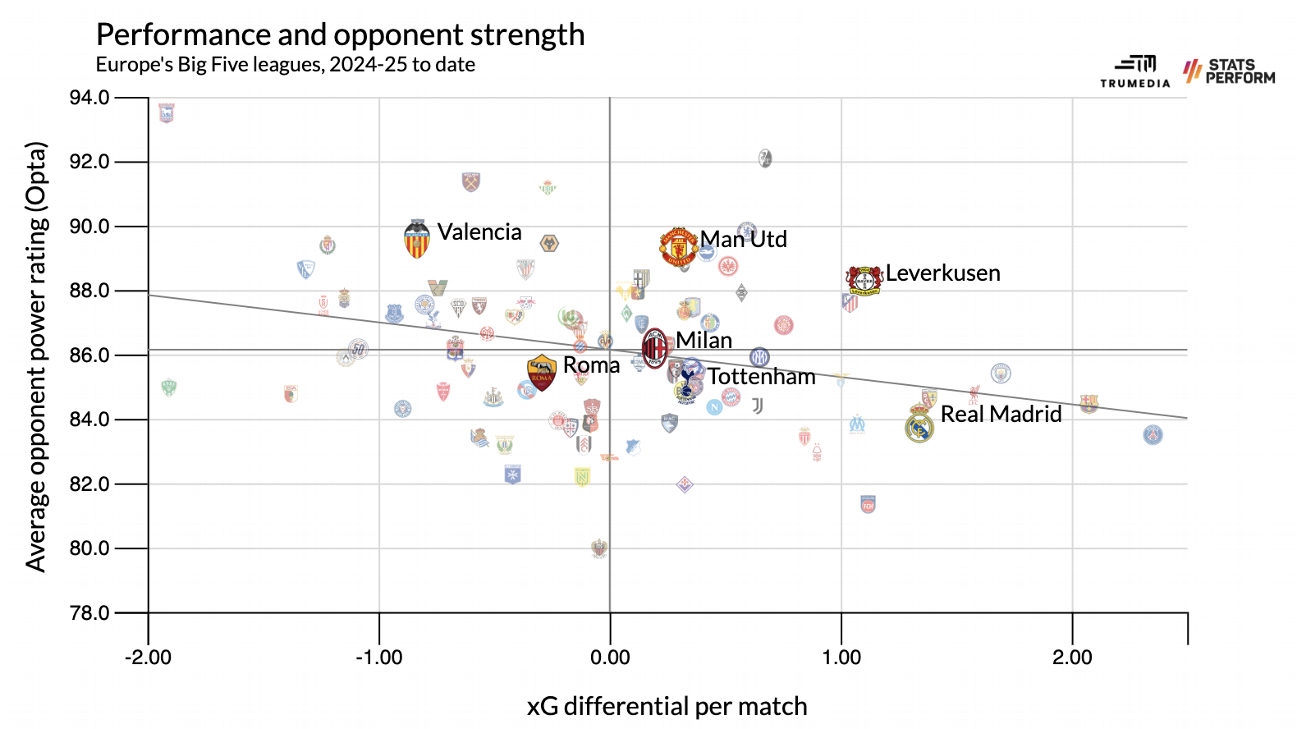 (Source: TruMedia)
(Source: TruMedia)
If you’re above the trendline in that chart, it means you’re producing an xG differential higher than what the average Big Five team could expect based on opponent quality. If you’re below the trendline, you aren’t.
Right now, Real Madrid are below the line. They’ve played what Opta thinks are only the eighth, 11th, 18th and 20th-best (out of 20) LaLiga teams, and they’ve produced an xG differential closer to fourth-place Girona’s than first place Barcelona’s. They’ve scored only the fourth-most goals in the league, too.
When you add Kylian Mbappé to a team that won the Champions League without Kylian Mbappe, you expect more. But perhaps a slow start was unavoidable.
Signing Mbappe gave them probably the best left-sided attacker in the sport when they already had what was probably the second-best left-sided attacker in the sport in Vinicius Jr. As I wrote in a transfer predictions piece last month:
“As individually talented as they are, [Mbappe and Vinícius] gravitate toward the same areas of the pitch in attack. While Mbappé in particular has played plenty of minutes in more of a centralized role, when he’s looking to shoot, he’s ending up in the top-left corner of the box. That’s where Vinicius tends to end up as well. If you’re an optimist, you might say this will result in some pretty terrifying two-versus-one or two-versus-two matchups for defenders; if you’re a pessimist, you might say this will result in clutter. No matter what, it might take these attacking players a little while to build chemistry in the attacking third.”
So far, this new attack hasn’t produced clutter: It basically has just pushed Vini Jr. out of the box. He’s averaging the same number of touches as he did last season (58.8 per 90 minutes), but he’s attempting both fewer and worse shots, and attempting fewer 1v1s in dangerous areas.
• 2023-24: 3.8 shots per 90 minutes, 0.16 non-penalty xG per shot, 2.0 1v1s in the box per 90
• 2024-25: 2.8 shots per 90 minutes, 0.07 non-penalty xG per shot, 1.3 1v1s in the box per 90
Vini’s primary role so far has been as a table-setter and since he’s Vini Jr., he’s very good at it. He’s first in the league in chances created (15) and second in expected assists from pass completions (1.3). The attack seems to go through him once the ball reaches the attacking third, and he’s a good facilitator.
Mbappe’s role, however, has been dramatically one-dimensional: don’t pass, just shoot.
• 2023-24 (PSG): 5.0 shots per 90, 0.14 non-penalty xG per shot, 49% of shots on target, 1.7 chances created per 90, 38.8 pass attempts per 90
• 2024-25 (Real Madrid): 6.7 shots per 90, 0.11 non-penalty xG per shot, 39% of shots on target, 0.3 chances created per 90, 26.7 pass attempts per 90
Among Big Five players with at least 100 minutes, only Napoli’s Khvicha Kvaratskhelia (6.8) is attempting more shots per 90 minutes, but Mbappe’s shot quality has sunk a bit, and his passing volume has plummeted. Since he has relegated Vini Jr. to more of a passing role, and doesn’t press even a slight amount despite being 25 years old and very fast — he’s averaging 1.3 ball recoveries per 90 minutes, half of what even Barcelona’s 36-year old Robert Lewandowski produces — his entire value is derived from how frequently he’s putting the ball in the net. And despite the ridiculous shot volume, he has scored only twice in four matches.
As a team, Real Madrid have managed to account for Mbappe’s lack of defensive presence in the aggregate, and are actually forcing more high turnovers than they did last season. While their goal average (1.75 per match) is lower than their xG average (2.0), they’ve underachieved against their season-long xG figures only once in the last 12 years, so that probably won’t remain the case for long.
They’re basically fine, in other words, even if they’re not getting the most they could out of either Mbappe or Vinicius (and even though star midfielder Jude Bellingham, who assisted a gorgeous Mbappe goal in the Super Cup, has sat out the last three matches because of a leg injury). But it appears the predicted growing pains have come to fruition, and they might need some favors from Barcelona to get back to the top of LaLiga.
Panic score: 2 out of 5. There’s nothing wrong that probably won’t be fixed, but Barca could be awfully hard to keep up with this season.
Didier Deschamps talks about the expectations on Kylian Mbappe to succeed with Real Madrid and the French national team ahead of their Nations League games.
• 2023-24: eighth in the Premier League (1.58 points per game, -0.0 goal differential per game)
• 2024-25 to date: 14th (1.00 points per game, -1.0 goal differential per game)
It wouldn’t be a Panic Index without Manchester United, would it?
After finishing eighth in the Premier League last season despite having the sixth-worst xG differential and the second-most shots allowed — suggesting they were lucky to finish eighth — the club’s new ownership was evidently persuaded by a nice FA Cup title run in electing to retain manager Erik ten Hag for another season. They spent more than €200 million to bring in attacker Joshua Zirkzee, defensive midfielder Manuel Ugarte, fullback Noussair Mazraoui and center-backs Leny Yoro and Matthijs de Ligt, but through three matchdays they currently sit six spots lower in the table than last season.
United are creating a solid number of good scoring chances (3.0 shots per game worth at least 0.2 xG), but none of those shots have ended up in the net, and they’re giving up nearly as many good chances as they’re creating: Opponents have averaged 2.7 shots per game worth at least 0.2 xG, and they’ve scored on five of the eight. United are creating fewer high turnovers (36.0 per game) than they’re giving up (39.0), they’re not tilting the field in their favor, and they’re creating very little from either counterattacking opportunities (only one counterattacking shot in three matches) or buildup play (11th in buildup attacks per game). Only three of their five new signings have been on the pitch — Yoro was injured in the preseason, and they took long enough negotiating the long-rumored Ugarte deal that he didn’t officially sign until Aug. 30 — and their best win of the season thus far was somehow coaxing €30m out of Napoli for midfielder Scott McTominay.
The self-inflicted problems haven’t really ceased, in other words, even if Yoro and Zirkzee are promising young players. The saving grace for United is that while they certainly don’t look like a potential top-four team, they also aren’t as bad as their results.
Despite having played both Liverpool and a hot Brighton, they’ve posted a decent xG differential of +0.3 per game — good for eighth in the league. That’s an improvement over last season, and they’ve primarily been slowed by unsustainably poor finishing. They’ve attempted shots worth about 5.2 xG and have turned those shots into only two goals. No team underachieves at that level for an entire season.
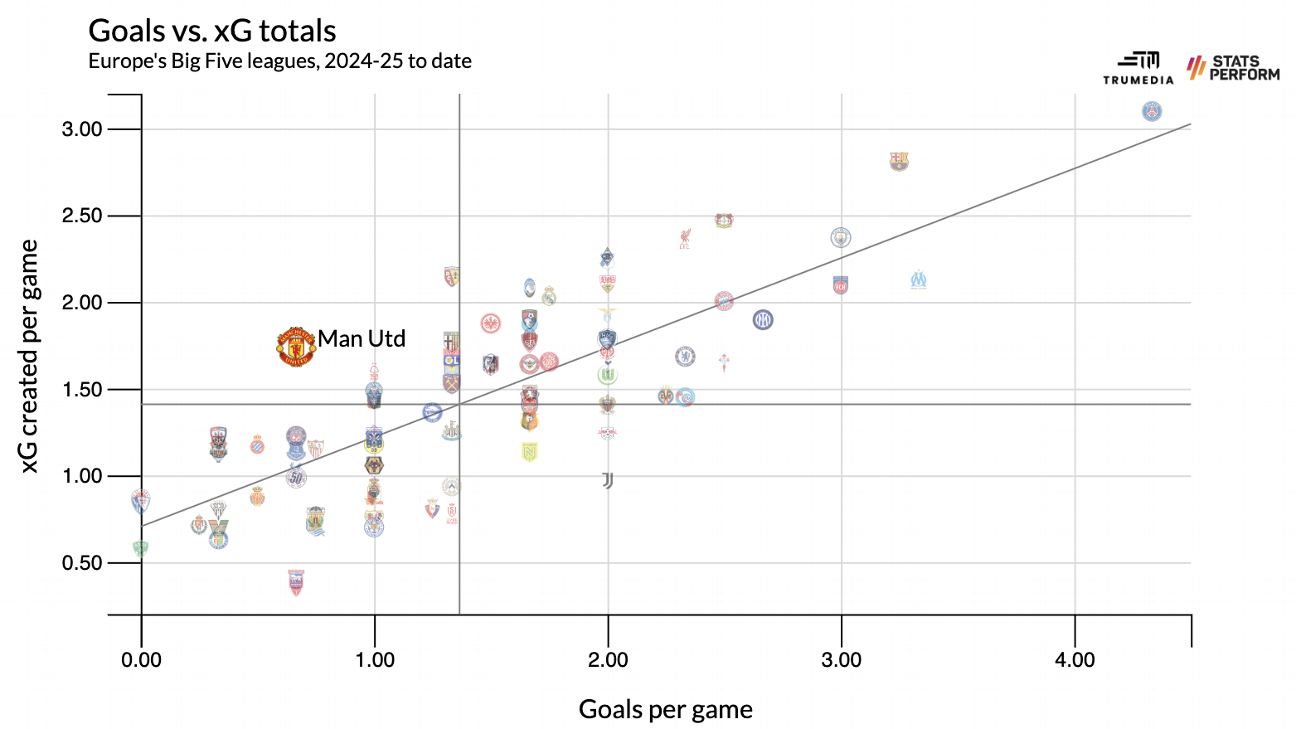 (Source: TruMedia)
(Source: TruMedia)
Zirkzee scored a lovely game-winner late in his debut against Fulham, and Amad Diallo scored to briefly tie the score against Brighton. Ten other United players have attempted 26 shots worth 3.9 xG and scored on none of them. That won’t last. Still, United are already four points outside of the top four, and three of those spots appear to already be reserved for Manchester City, Arsenal and Liverpool at the end of the season. Opta currently gives ten Hag’s team a 7% chance of finishing in the top four and a 16% chance of finishing in the top five. That’s dreadful for a team that spends at a Champions League level, even if they’re not as bad as their results appear.
Panic score: 5 out of 5. For a normal eighth-place finisher, I would say this is about a 2, but United are never allowed to have a panic score under 5.
Julien Laurens says Erik ten Hag’s reaction to criticism of his Manchester United side shows that he is already on edge.
• AC Milan, 2023-24: second in Serie A (1.97 points per game, +0.7 goal differential per game)
• AC Milan, 2024-25 to date: 14th (0.67 points per game, -0.3 goal differential per game)
• Spurs, 2023-24: fifth in the Premier League (1.74 points per game, +0.3 goal differential per game)
• Spurs, 2024-25 to date: 10th (1.33 points per game, +1.0 goal differential per game)
Last season, Paulo Fonseca’s Lille were one of Europe’s true possession masters, dominating the ball and counterpressing beautifully. They didn’t quite have the raw scoring panache to threaten PSG, but the fact that Milan wanted to play “Fonseca Ball” and hired him away this summer made sense. Meanwhile, Ange Postecoglou’s Spurs were rather chaotic out of possession last season but played their own fun and ball-dominant style.
The thing about possession-and-pressing teams is if your pressing game isn’t tuned just right, you’re going to have some serious problems in transition. You’re going to end up with heavy possession totals, and you’re going to attempt far more shots than your opponent, but opponents’ shot quality will do serious damage.
I think it’s safe to say neither Milan’s nor Spurs’ pressing games are tuned just right as of yet.
 (Source: TruMedia)
(Source: TruMedia)
Among the 96 teams in Europe’s Big Five leagues, Spurs rank first in possession (68.5%) and 10th in shots-per-possession margin (+0.08). Milan ranks 20th (57.9%) and ninth (+0.08), respectively. In terms of Field Tilt (the percentage of all attacking-third passes a team attempts in a game), Spurs rank first (83.0%), and Milan rank ninth (71.3%). All good things.
But in Spurs’ 2-1 loss to Newcastle, they attempted 20 shots worth just 1.3 xG, and Newcastle attempted nine worth 1.8 and won the match on a picture-perfect quick-strike goal by Alexander Isak. Against Leicester, they tilted the pitch nearly off its axis (85.8% field tilt) but gave up an easy Jamie Vardy goal from five meters out in what was almost Leicester’s only quality attack of the match.
Spurs have at least won a match, though; Milan has had to settle for draws against Torino and Lazio, and a dire 2-1 loss to recently promoted Parma. They’ve given up five goals (plus an own goal), and all five were (a) attempted within nine meters of the goal and (b) worth at least 0.46 xG.
For Milan, these problems are both worse and more understandable. They do, after all, have a new manager, and he has started an outlandish 19(!) different players in three matches. He’ll theoretically figure out his rotation at some point, and Milan will begin to gel. But how many points will they have dropped in the interim?
For Spurs, however, this start has to feel awfully disappointing. You expect chaos and breakdowns in a manager’s first season when he’s attempting such a high-wire playing style, and while their overall defensive numbers have improved this season — they’re giving up only 1.0 goals per match after giving up 1.6 last season, after all — opponents’ average shot quality has risen, and the breakdowns have already cost them four or five points. When 17 Premier League teams are basically fighting for one top-four spot, that feels twice as costly.
Panic score: 2 out of 5 for Milan, 3 out of 5 for Spurs. The breakdowns probably will slow moving forward, but they’ve already cost some points.
• 2023-24: sixth in Serie A (1.66 points per game, +0.5 goal differential per game)
• 2024-25 to date: 17th (0.67 points per game, -0.3 goal differential per game)
On paper, Roma had a pretty productive offseason. They retained manager Daniele De Rossi, who produced strong results in the spring after replacing Jose Mourinho last season, and they signed both last year’s leading LaLiga scorer, Artem Dovbyk, and tantalizing young winger Matìas Soulè. De Rossi is good at the “possession as the best form of defense” approach, and among the teams in Europe’s Big Five leagues, Roma ranks 12th in Field Tilt (70.1%) and both 12th in shot attempts (49) and 11th in goals allowed (two).
That all seems like a pretty good combination … except that only one of their 49 shots has gone in the net, with Dovbyk and Soule combining for 11 shots worth 1.3 xG in 489 minutes without scoring. Neither have Paulo Dybala (seven shots worth 0.3 xG), Lorenzo Pellegrini (seven shots worth 0.5 xG) or substitute Tommaso Baldanzi (four shots worth 0.2). In three matches, they’ve produced 0-0 draws against Juventus (acceptable) and Cagliari (less so), and they lost the only match in which they scored, an unfortunate 2-1 loss to Empoli.
The finishing is both poor and, as with Manchester United, probably unsustainable. That’s the good news. The bad news: Opponents also haven’t been able to shoot. Roma have allowed shots worth 4.3 xG and given up only two goals. Despite their own poor finishing, their goal differential (-0.33 per match) and xG differential (-0.27) are almost dead on. Opponents are just as likely to improve their finishing as Roma are. Not great.
Panic score: 4 out of 5. Against what Opta thinks are the second- and seventh-worst teams in Serie A, Roma managed only one point, and they’re already five points outside Italy’s top four. This isn’t the start De Rossi envisioned.
• 2023-24: first in the Bundesliga (2.65 points per game, +1.9 goal differential per game)
• 2024-25 to date: eighth (1.50 points per game, +0.0 goal differential per game)
Granted, saying what place a team is in after two matches is pushing it, even by the standards of this small-sample exercise. Heidenheim, after all, currently “leads” the Bundesliga after wins over what Opta says are the third- and fourth-worst teams in the league (St. Pauli and Augsburg). I’m all for a shocking Heidenheim title push — the more the world learns about their amazing manager Frank Schmidt, the better — but I’m going to go ahead and proclaim that unlikely.
Bayer Leverkusen have lost one Bundesliga match in the last 15 months, and I’m pretty sure manager Xabi Alonso is incapable of panicking. So why are they on this list? It’s simple: because their defense is just not right.
There were warning signs of this in preseason friendlies, and in three matches against top-division teams this year — against Stuttgart in the German Super Cup, plus Borussia Monchengladbach and RB Leipzig in league play — they’ve given up seven goals. They blew a 2-0 lead before salvaging a late win against Gladbach, and their more than yearlong league unbeaten streak came to an end on Saturday when a 2-0 lead over RBL at home turned into a 3-2 loss.
Leverkusen allowed shots worth just 0.9 xG per match last season, and in two league matches this time around, that average is up to 1.4 in 2024-25. The main culprit: passivity. They allowed 13.3 passes per defensive action and began 10.9% of possessions in the attacking third during last year’s title run; this year those numbers are 16.5 (86th out of 96 in the Big Five) and just 6.6% (61st), respectively. They’re allowing opponents to turn buildup play into shots at a far greater level than in 2023-24.
 (Source: TruMedia)
(Source: TruMedia)
This chart shows us that from most of the defensive and middle thirds of the field, opponents are creating far more shot attempts than they did last season.
In all, Leverkusen just appear a bit hungover this season and their attention span a bit wayward. They needed a comeback to beat Stuttgart in penalties in the Super Cup, they’ve blown leads in both league matches, and even their DFB Pokal win — 1-0 over fourth-division Carl Zeiss Jena — was a do-the-bare-minimum affair. Perhaps this was unavoidable following last season’s record-setting success, and perhaps all of those late comeback wins lulled them into thinking they’ll always get away with lapses. But Alonso won’t want this lull to last much longer.
Panic score: 3 out of 5. Hangovers happen, but you’ll want to snap out of this before the Champions League begins … or before you fall too much further behind Bayern and Leipzig.
• 2023-24: ninth in LaLiga (1.29 points per game, -0.1 goal differential per game)
• 2024-25 to date: 20th (0.25 points per game, -1.0 goal differential per game)
The other teams on this list have either the financial heft or recent successes to make them ambitious. Valencia have finished between ninth and 16th in LaLiga for five consecutive seasons and nearly got themselves relegated in 2022-23, so they don’t quite fit that profile. But they perked up in 2023-24, jumping back to ninth despite manager Ruben Baraja giving tons of minutes to younger players. That made them intriguing to me heading into this season. And this season almost couldn’t possibly have started any worse.
They lost to Barcelona, Celta Vigo and Athletic Club to start the season and let a lead slip away in a 1-1 draw with Villarreal. Granted, they’ve already played two of last season’s top five finishers (and Villarreal has begun this season quite well), but having the worst point total and second-worst goal differential in the league 10% of the way through the season wasn’t the vision.
Is there something seriously wrong? Not really, at least as long as they eventually start turning a tilted field into actual opportunities.
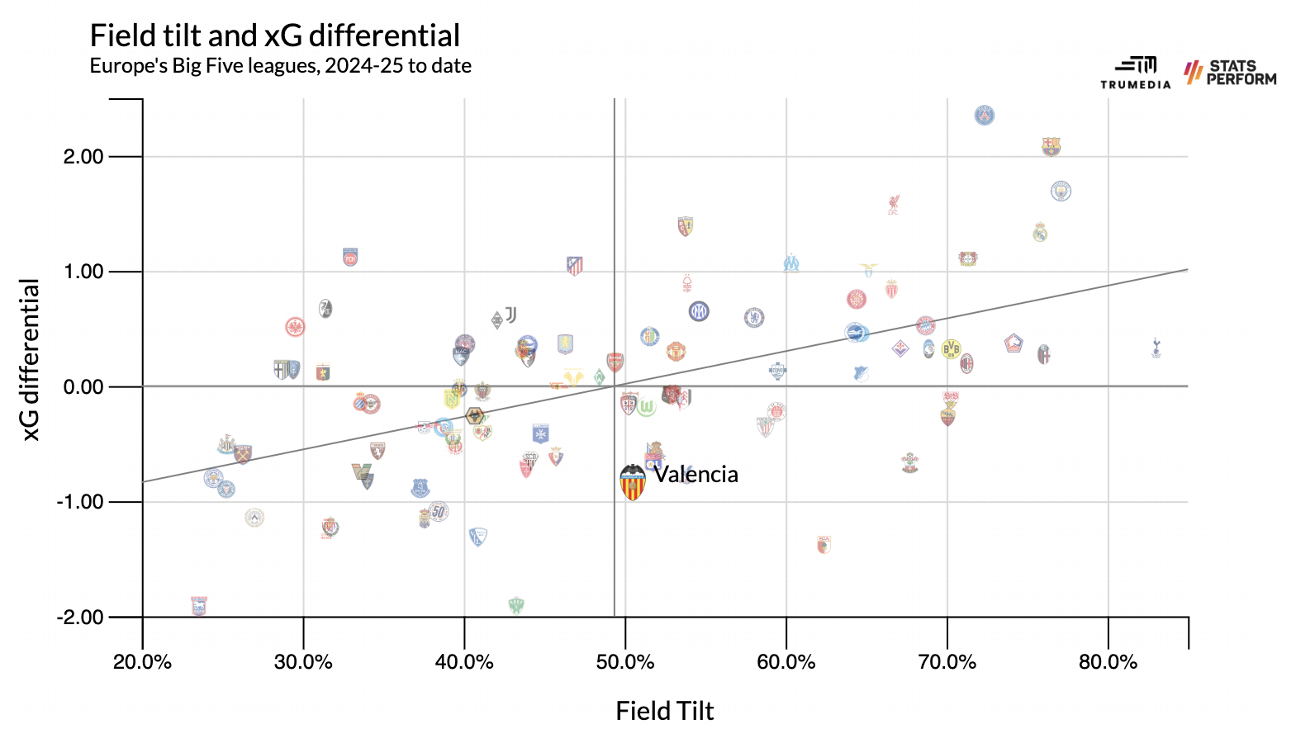 (Source: TruMedia)
(Source: TruMedia)
Valencia are forcing 44.5 high turnovers per match (26th among teams in Europe’s Big Five leagues) and are starting possessions 2.7 meters farther up the pitch than opponents on average (28th). But they’re attempting the same number of shots as opponents, attempting no shots of value (86th in xG per shot) and giving up tons of value on the other end (83rd in xG per shot allowed). They have no good ideas when they enter the attacking third — 58% of their shots are outside the box (75th), and 28% are headers (13th most), and while they attempt an above-average number of crosses, they’re only completing 17% of them (77th). On top of all that, star goalkeeper Giorgi Mamardashvili, on his way to Liverpool next year, has stopped shots at a below-average rate thus far.
Maybe this all clears up when the schedule eases up. After all, on the XG differential-versus-opponent power rating chart at the top, they were on the right side of the trend line. But they’ve dug themselves quite a hole in the meantime, and it’s hard to imagine anything beyond another ninth- to 16th-place finish.
Panic score: 3 out of 5. They aren’t the worst team in Spain, but spending an international break in last place probably doesn’t do much for the nerves.

